
Caleana, commonly known as duck orchids, is a genus of flowering plants in the orchid family, Orchidaceae that is found in Australia and New Zealand. The Australian species are found in all states but have not been recorded in the Northern Territory. Duck orchids have a single leaf and one or a few, dull-coloured, inconspicuous flowers. Most species are found in Western Australia but one species occurs in eastern Australia and one occurs in eastern Australia and New Zealand. Orchids in this genus as well as the hammer orchids (Drakaea) are pollinated by male thynnid wasps.
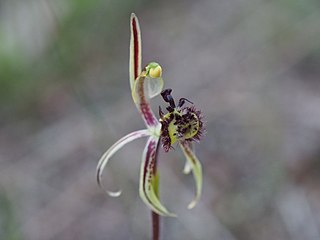
Caladenia barbarossa, commonly known as the common dragon orchid is a species of orchid endemic to the south-west of Western Australia. It can be distinguished by its distinctive labellum which is attractive to species of male thynnid wasps.

Caladenia longicauda subsp. crassa, commonly known as the Esperance white spider orchid, is a plant in the orchid family Orchidaceae and is endemic to the south-west of Western Australia. It has a single hairy leaf and up to three mostly white flowers with long, broad, spreading lateral sepals and petals, a relatively broad labellum with short, narrow teeth. It grows on the south coast between Bremer Bay and the Cape Arid National Park.

Caladenia longicauda subsp. eminens, commonly known as the stark white spider orchid, is a plant in the orchid family Orchidaceae and is endemic to the south-west of Western Australia. It has a single hairy leaf and up to three large, bright white flowers with long, broad, spreading lateral sepals and petals, a relatively broad labellum with short, narrow teeth. It is a relatively common orchid found in a broad band, mainly between Tenterden and Jerramungup.
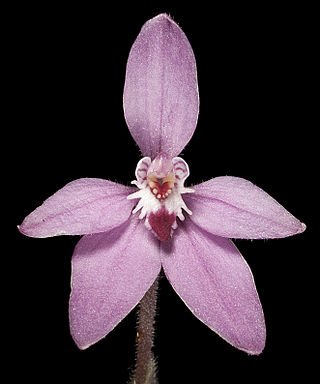
Caladenia reptans subsp. reptans, commonly known as the little pink fairy or dwarf pink fairy, is a plant in the orchid family Orchidaceae and is endemic to the south-west of Western Australia. It has a single hairy leaf and up to three relatively small, pink flowers which have a labellum with three distinct lobes.

Caladenia gemmata, commonly known as the blue china orchid, is a plant in the orchid family Orchidaceae and is endemic to the south-west of Western Australia. It has a small, oval leaf and up to three intense blue to mauve flowers. It is the most common and widespread of the West Australian china orchids, sometimes appearing in large numbers after summer fires.
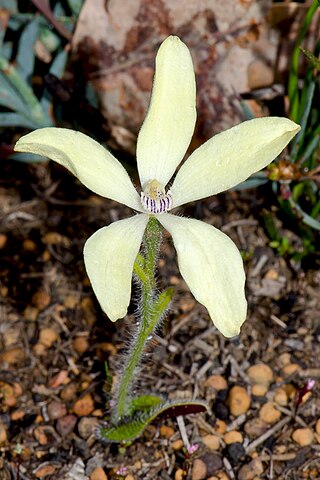
Caladenia ixioides, commonly known as the white china orchid, is a plant in the orchid family Orchidaceae and is endemic to the south-west of Western Australia. It has a single, broad, flattened leaf and up to three yellow or white flowers. It mostly only occurs in woodlands and forest near Perth. It was previously known as Cyanicula ixioides.

Caladenia sericea, commonly known as the silky blue orchid, is a plant in the orchid family Orchidaceae and is endemic to the south-west of Western Australia. It is a common orchid in the high rainfall areas of the state and has a single, broad, silky leaf and up to four blue-mauve flowers.

Caladenia emarginata, commonly known as the pink enamel orchid, is a plant in the orchid family Orchidaceae and is endemic to the south-west of Western Australia. It is a ground orchid with a single flattened, hairy leaf and up to four glossy pink flowers. It is similar to Caladenia brunonis but is usually a shorter plant but with larger, pink flowers. It has been known as Elythranthera emarginata since 1963 but recent discoveries suggest its inclusion in the genus Caladenia.
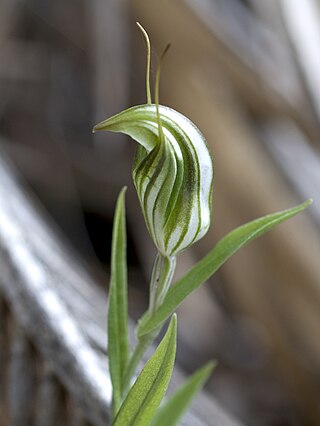
Pterostylis scabra, commonly known as the green-veined shell orchid, is a species of orchid endemic to the south-west of Western Australia. As with similar orchids, the flowering plants differ from those which are not flowering. The non-flowering plants have a rosette of leaves but the flowering plants lack a rosette and have a single flower with leaves on the flowering spike. This greenhood has a white flower with green and pale brownish-fawn stripes and a long, curved protruding labellum. It is found in inland areas between Kalbarri and Esperance.
Caleana alcockii, commonly known as Alcock's duck orchid is a rare species of orchid endemic to the south-west of Western Australia. It has a single smooth leaf and is distinguished by its humped labellum and relatively late flowering period. It only occurs north of Geraldton.

Caleana brockmanii, commonly known as Brockman's duck orchid is a species of orchid endemic to the south-west of Western Australia. It has a single smooth leaf, a single greenish yellow and red flower and is distinguished by its flat labellum, relatively late flowering period and calli only near the tip of the labellum. It is found south from Perth.

Caleana triens, commonly known as broad-billed duck orchid is a species of orchid endemic to the south-west of Western Australia. It has a single smooth leaf and is distinguished by its flattened labellum with calli only near its tip and by its relatively early flowering period.
Caleana disjuncta, commonly known as the little duck orchid, is a species of orchid that is found in Western Australia but with a few disjunct populations in Victoria and South Australia. It has a single smooth leaf and a single greenish yellow and red flower with a flattened labellum, the calli only near its tip.

Caleana dixonii, commonly known as the sandplain duck orchid is a rare species of orchid endemic to the south-west of Western Australia. It has a single smooth leaf and a single greenish yellow and fawn-coloured flower. It is distinguished by its flattened labellum with calli only near the tip of the labellum and its preference for growing on sandplains.

Caleana gracilicordata, commonly known as the slender-leafed duck orchid is a species of orchid endemic to the south-west of Western Australia. It is a small, late flowering duck orchid with a single small, smooth, heart-shaped leaf and a single greenish yellow and red flower. It usually grows in mossy places on granite outcrops.
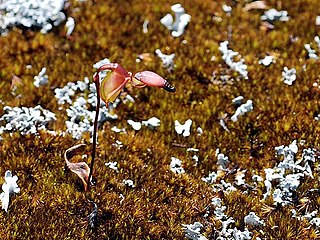
Caleana granitica, commonly known as the granite duck orchid is a species of orchid that is endemic to the south-west of Western Australia. It is a species of duck orchid with a single smooth leaf and a single greenish yellow and red flower with the labellum held below the horizontal. It grows on a single granite outcrop near Armadale.

Caleana hortiorum, commonly known as Hort's duck orchid is a species of orchid endemic to the south-west of Western Australia. It has a single smooth leaf, a single greenish yellow and red flower and is distinguished by its long, narrow, slightly humped labellum, with calli on its outer half. It is found between Perth and Albany.
Caleana parvula, commonly known as the Esperance duck orchid is a species of orchid endemic to a small area near Esperance in the south-west of Western Australia. It has a single smooth leaf and usually only a single greenish yellow and red flower. It is distinguished by its small flower with the calli only on the outer one-fifth of the labellum. The only other Caleana species in Western Australia which is smaller is C. lyonsii.
Caleana terminalis, commonly known as smooth-billed duck orchid is a species of orchid endemic to a small area near the Murchison River in the south-west of Western Australia. It has a single smooth leaf and usually only a single greenish yellow and red flower. It is distinguished by its slightly humped labellum, with calli only on its outer one fifth.
















